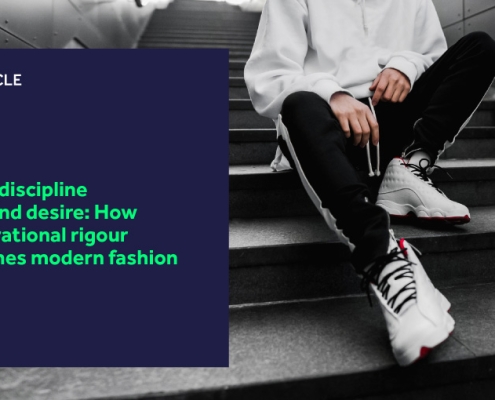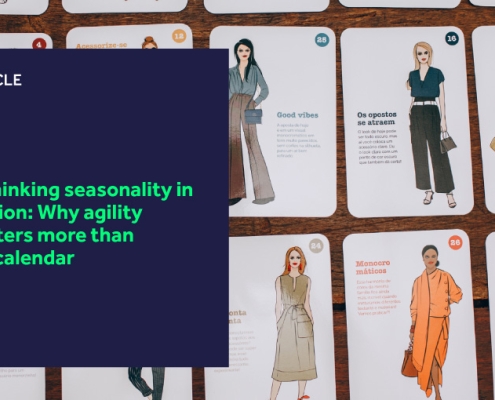Luxury fashion finds itself in a precarious situation following years of accelerated growth post-pandemic. Over the last year or so, declines in growth, shifting consumer sentiment and increasingly complex operational challenges have created a troubling landscape for brands.
Traditional luxury powerhouses are under pressure to reinvent themselves from younger generations while older demographics expect traditional experiences.
Pair the generational divide with technological disruption and global economic uncertainties and it’s easy to see why brands find themselves caught in limbo.
Executive summary
In this piece, we delve into the structural challenges confronting luxury fashion, from supply chain vulnerabilities to shifting brand perceptions to the urgent imperative of digital excellence. Key challenges facing brands include:
- The decline of hyper-growth in traditional markets
- The emergence of new regional luxury ecosystems
- A profound generational divide in luxury consumption
- Operational inefficiencies eroding brand margins and relevance
The overall message is clear: luxury fashion needs a strategic recalibration.
Brands that adapt with agility and insight will not just survive but ultimately flourish in the face of adversity. Those that resist change risk becoming relics of a bygone era.
Luxury is a market in flux
While luxury fashion enjoyed some years of significant growth following the pandemic, it is currently enduring its first period of sustained contraction in over a decade.
McKinsey’s research found that with economic profit decreasing 19% year-on-year, this isn’t merely a cyclical downturn but a structural realignment of the luxury ecosystem.
Indeed, with new tech breaking through and consumer behaviour continuing to evolve, the situation is far more nuanced than a simple slowdown in growth.
Luxury’s traditional growth engines – the US, China and Europe – are experiencing considerable volatility. China, once the king of luxury consumption, is now projected to see flat or potentially negative growth (-3% to 0%), a stark contrast to its previous double digit expansion.
The US and European markets seem more positive, with estimates suggesting that they could offer marginal growth of 3-4%, but this will be insufficient to counterbalance the Chinese market’s deceleration.
This shift is driven by several factors, namely:
- Persistent geopolitical uncertainties
- Eroding consumer confidence
- Increasing price sensitivity
- Fundamental changes in generational spending patterns and values
The notion that luxury is an immutable, recession-proof sector is quickly becoming obsolete. According to McKinsey, only 20% of industry execs expect improved consumer sentiment while 39% anticipate further market deterioration.
This pessimism isn’t unfounded. Despite rising economic pressures, luxury started the year as the sole sector experiencing margin compression while simultaneously maintaining the highest bottom-line margins.
Luxury’s emerging markets
Traditional luxury markets may be stagnating, but there are new regions emerging that could help propel the sector from the current downturn.
As per The State of Fashion 2025, the spotlight currently sits on the following countries and regions:
India
- Projected GDP growth of 7% in 2025
- Expanding middle class (expected to grow from 430 million to 1 billion by 2050)
- 50% projected increase in ultra-high-net-worth individuals between 2023 and 2028
Southeast Asia
- Rising digital penetration
- Growing middle-class consumption
- Increasing appetite for premium and luxury experiences
Middle Eastern markets
- UAE and Saudi Arabia projecting 15-20% annual luxury growth
- Strong digital commerce infrastructure
- Young, digitally native consumer base
Both the numbers and consumer context paint a positive picture, but it’s wise to remember that success isn’t guaranteed in these markets.
It’s almost never simple expanding into new territories.
Between regulatory nuances, cultural expectations, unique digital consumption patterns and localised marketing strategy considerations, there is plenty for brands to contend with.
Luxury’s dual imperative
Perhaps the most seismic shift for luxury brands lies in the growing generational divide. Millennials and Gen Z are not just changing luxury consumption, they’re redefining its entire concept.
By 2030, it’s estimated that these generations will command approximately 70% of global luxury spending, bringing fundamentally different values and expectations into play.
The key characteristics that define these generations include:
- 50% less brand-loyal compared to previous generations
- Prioritise authenticity over heritage
- Demand ethical and sustainable practices
- Seek personalised, meaningful brand interactions
- Value digital-first experiences
On the flip side, the Silver Generation – who are currently buoying the luxury market – remain critical to bottom lines in the short-term.
In the US, for example, individuals over 55 control 72% of national wealth and are driving 60% of incremental spending growth.
This creates a seemingly impossible situation for luxury, particularly in regards to brand identity. Traditional markers of prestige that appeal to older cohorts don’t resonate the same way for their younger counterparts.
Instead, they favour authentic brand narratives, meaningful community connections, personalised experiences and sustainable practices, factors that, while important, mean less to silver spenders.
The stark difference in the wants and needs of the Silver Generation and Gen Z has effectively ensnared brands in a pincer movement, creating a dual imperative that must be fulfilled.
Luxury brands must simultaneously honour traditional values and serve silver spenders while attracting and nurturing digital natives.
Naturally, this bears strategic implications for the luxury fashion market. Brands can no longer rely on the old ways and instead must find fresh tactics to appeal to both younger and older shoppers. Or, ideally, bridge the divide altogether. This will likely include:
- Developing hyper-localised market strategies
- Investing in digital transformation and tech that enhances human connection
- Creating authentic, purpose-driven brand narratives
- Building flexible, data-driven operational models
Those that are able attract, nurture and retain both cohorts will be well poised for success over the coming years.
Luxury’s need for digital transformation
The wider fashion industry, luxury included, is still plagued by overproduction, with estimates suggesting that between 2.5 and 5 billion surplus items are created annually… representing $70-$140 billion in wasted value.
These figures shine a light on the inventory and supply chain issues that affect all brands, with persistent disruptions and rising logistics costs continuing to erode profit margins.
In fact, between December 2023 and February 2024, shipping costs from Asia to the US increased by a staggering 165%, highlighting just how volatile the market has become.
With a limited ability to predict and respond to fluctuating consumer demands, it’s clear luxury brands need more robust systems and recalibrated manufacturing footprints in place to mitigate disruption and volatility.
Nearshoring, for instance, is one tactic that many brands have explored (investments have increased 20% in the US and 8% in Europe). However, macroeconomic factors, like Trump’s tariff increases, have thrown a wrench in these plans.
Brands with headquarters in the US who look to nearshore may well be able to slash their lead times and some of their logistics costs, but now they will be forced to pay extra to import their goods.
They will likely pass the costs onto consumers as a result, but this could well lead to US consumers purchasing less from these brands.
This will also impact any brand outside of the US that relies on American consumers, but it will likely be less pronounced.
To complicate matters further, luxury brands are still struggling to create meaningful digital experiences that resonate across generations. As McKinsey revealed:
- 71% of fashion executives are planning to increase brand marketing investment
- 68% of consumers are dissatisfied with sponsored social media content
- 65% are turning away from traditional fashion influencers
- Aspirational consumers still value human interactions, seeking staff styling advice
This creates something of a digital engagement paradox for brands to contend with.
The challenge isn’t simply about having an online presence, but creating authentic, personalised digital experiences that complement, rather than replace, traditional luxury service models.
Luxury as a whole must embark on a significant digital transformation journey. This doesn’t just include back-office systems but consumer-facing tech too.
Brands must find ways to better align inventory with demand, gain tighter control over their expenses, and create genuine brand narratives that consumers can buy into.
Luxury’s blind spot – sustainability
Before AI dominated discourse in the fashion industry, sustainability was the big thing.
It has fallen down corporate priority lists dramatically, in large because there are more pressing issues, but it does remain crucial.
The worry is that, according to McKinsey’s research, 63% of brands are not on track to meet their emission goals set in 2023.
This fact will eventually fall under scrutiny given that younger consumers continue to state that they want ethical and transparent practices.
There is some progress in this regard. Circular economy models are still gaining popularity and resale markets are booming.
In fact, the global resale market was estimated to be worth $50 billion in January 2025.
Clearly, strides are being made to meet the demand for sustainability but one facet that remains a grey area is the supply chain.
It won’t be long before luxury brands are forced into making more ethical decisions in their supply chains but the problem is, and this is true for many fashion brands, they’re unable to disclose too much information because they don’t have it.
Nevertheless, this is indeed a cause for concern and one that must be addressed in the coming years, even if it remains lower on the list of priorities.
K3’s strategic response to luxury’s challenges
Traditional luxury approaches may be failing, but that doesn’t need to be inherently negative. It’s an opportunity for brands to gain an edge amid market turmoil.
Our tailored fashion solutions, embedded in Microsoft’s leading D365 ERPs, provide a backbone for luxury brands to address many of their most pressing issues.
Below, we outline some of the core functionalities that our solutions provide that can help with the challenges described in this piece.
Smarter raw material management
One challenge luxury companies face that is slightly different to other fashion brands is that they can often face extended lead times due to the scarcity of the raw materials they require.
Given that supply chain disruptions continue to cause headaches and shipping costs can suddenly spike, the ability to better manage raw materials is an essential way to help protect bottom lines.
Our K3 Fashion solution helps mitigate these impacts by:
- Providing real-time visibility into material quantities and availability
- Enabling proactive supply chain forecasting
- Supporting parallel activity planning to engage suppliers before final commitments
- Identifying potential production bottlenecks before they impact operations
These factors combine to allow brands to manage their supply chains and raw materials more effectively, which in turn can have a positive impact on their operations.
Ringfencing: A strategic approach to inventory allocation
If raw materials are particularly scarce, production inevitably becomes impacted. In this instance, brands need the ability to allocate stock to where it’s most needed to protect margins.
K3 Fashion can help here through its ringfencing functionality, which can:
- Reserve inventory for VIP clients and key customer groups
- Limit product availability by item, collection, or geographic region
- Create flexible allocation strategies that preserve brand exclusivity
- Implement sophisticated order management mechanisms
K3 Fashion’s ringfencing is a powerful tool that completely transforms brands’ inventory allocation. Whether they need to reserve stock for key customers or markets during periods of scarcity, or allocate specific stock to specific channels for specific demographics, K3 Fashion is a game changer.
Guarantee uncompromising quality
Luxury items are considered “luxury” for a reason, because they’re exceptional in quality. It doesn’t matter which age demographic a brand serves; its items must be up to standard.
However, not every fashion ERP system can support brands with this.
K3 Fashion recognises that true luxury is, in part, about control. Our system goes beyond basic tracking, offering a comprehensive approach to quality.
It provides the ability to:
- Track materials across multiple products and colour batches
- Identify and isolate potential issues instantly
- Manage material scarcity with precision
- Group related items sharing critical materials
Furthermore, K3 Fashion also embeds quality assessment throughout the entire production process. This is important to note since most ERPs only allow quality control at the end of production. But we extend D365 to change this and provide:
- Support for multiple sample types (proto-samples, salesman samples etc.)
- Quality assessments embedded throughout the production process
- Material traceability across products and colour batches
- Immediate issue identification and action tracking
By embedding quality control throughout, luxury brands can work safely knowing that they’ll meet the exceptional standards that define luxury.
Champion Corporate Social Responsibility (CSR)
While sustainability isn’t at the forefront of the industry right now, we recognise that it is important and that brands should have easy ways to help drive their own personal CSR agendas.
K3 Fashion’s CSR module offers brands:
- Comprehensive supplier and material classifications
- Certification tracking for social and environmental standards
- Automated transaction rules to enforce CSR criteria
- Transparent reporting to meet evolving regulatory requirements
The key point here is that brands can freely establish their own CSR transaction rules – to either block or allow call orders – to ensure they work how they want.
Our CSR module isn’t a magic wand and won’t fix sustainability issues overnight, but it is much, much more than a start. And on that note…
Demystifying the supply chain with product passports
People want to know more about what happens in a fashion brand’s supply chain, but providing that information can be difficult.
This is an issue that luxury brands want to solve. Another problem luxury brands face is counterfeit goods. Provenance has long been a struggle for luxury brands, and this is an area that we will soon be able to help with massively.
Within Microsoft’s Dynamics 365 Finance & Supply Chain Management, there is already support for serialisation. We are working on extending this to create a product passport.
The product passport will accompany an item and/or raw materials throughout the supply chain, logging all relevant data to support CSR and sustainability initiatives and provenance.
It’s set to be a powerful tool to not only prove authenticity but also help brands gain a significantly better understanding of their product’s life to make more informed decisions going forward.
The time for change is now
If anything should be crystal clear, it’s that luxury’s traditional playbook is no longer sufficient. Brands that fail to adapt to shifting market forces will lose their relevance while those that embrace everything we’ve outlined in this article will flourish.
At K3 Fashion Solutions, we don’t just offer technology, we provide a strategic toolkit to help brands redefine and improve their operations. We’re not a cost but an investment.
If you’d like to explore how we can support you, feel free to drop us a line today.
 https://k3fashionsolutions.com/wp-content/uploads/2025/10/discipline-behind-desire-featured.jpg
510
900
Jordan Heal
https://k3fashionsolutions.com/wp-content/uploads/2024/12/K3_Fashion_Solutions_Half-color_RGB.svg
Jordan Heal2025-10-14 15:17:472025-10-14 15:17:47The discipline behind desire: How operational rigour defines modern fashion
https://k3fashionsolutions.com/wp-content/uploads/2025/10/discipline-behind-desire-featured.jpg
510
900
Jordan Heal
https://k3fashionsolutions.com/wp-content/uploads/2024/12/K3_Fashion_Solutions_Half-color_RGB.svg
Jordan Heal2025-10-14 15:17:472025-10-14 15:17:47The discipline behind desire: How operational rigour defines modern fashion


